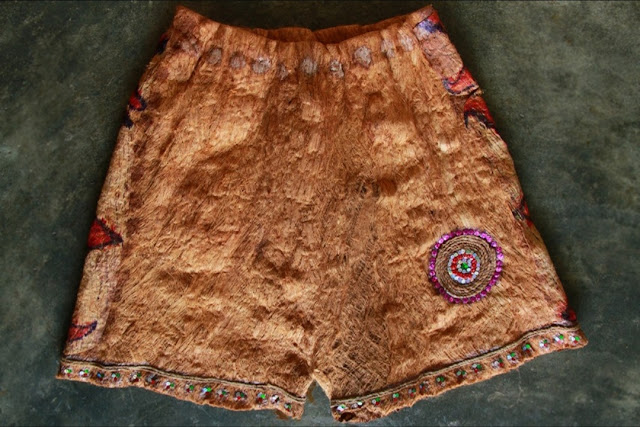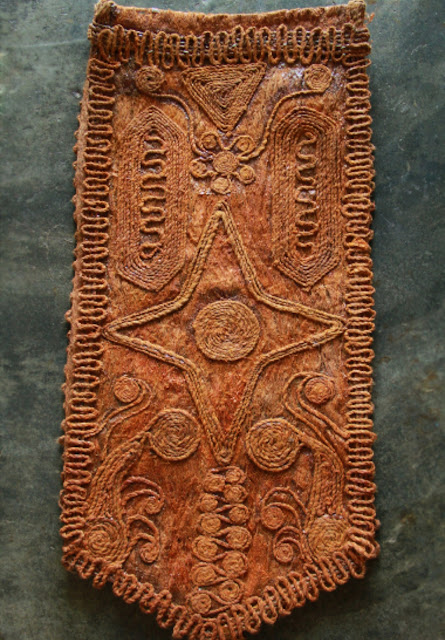Dayak Salako Traditional Clothes
Most Dayak Salako people, farming, hunting and cutting rubber, their lives are very simple, do not have a prominent identity, like a coastal dayak. Dayak Salako upholds customary law. Dayak Salako mediates between warring tribes. the function of customary law is not only deterrent, but still reconciles the two conflicting parties.
Bagak Sahwa Village, Singkawang saves a great diversity of Salako's Dayak culture. One of them is the traditional Dayak Salako outfit that has been created by the Head of the Dayak Tribe Salako, FX. Adam. traditional clothes, among others, are ribs in the form of wrist bracelets and bracelets for feet. Whereas the capuak is the cover of the Dayak Salako male genitalia and pants for women. candit is a belt, red headbands for men and red kedung for women as well as hats with hornbill beaks that are characteristic of the Dayak Salako Tribe. This Dayak Salako outfit was created in such a way as to enrich Dayak Salako's culture and be used for grand customary events.
Biusuk, kapuak, candit, women's vest, men's vest pants, headband and hat and Ruai's bird's tail which are the hallmarks of Dayak Salako. created by giving fruit from the tree of ipuh which is arranged one by one into beads that decorate every Dayak Salako traditional dress. The remaining bark fibers are used to make some decorating motifs by attaching glue to each ingredient.
the processing process of the attributes created from the bark which is still wet is beaten so that it is easily formed, then dried. For the thread, pineapple tree fibers are used, also the roots of wood are used in the forest. Chopsticks are made from Tembesi logs and given beautiful carvings. while chopsticks are created in such a way as to race and place chopsticks which are also made of bark.
For hundreds of years the ancestors of Dayak Salako used clothing from the bark of trees. In this case, FX efforts. Adam to preserve the ancestral heritage that once triumphed in his time. During the Japanese occupation, this traditional dress was still used. In the Netherlands, there are documents that reinforce the Salako Dayak tribe ancestors enshrined in a photograph.
the Dayak Salako tribe has an oversized traditional ceremony covering the Samsam ceremony (Nyepi ceremony), Baketo ceremony (a ceremony to take wood in the forest, to avoid danger and ask permission from the forest authorities). Nyang Padi ceremony (custom when finished grazing is then done by ritual). Nanam Pabanihan ceremony (done by sowing seeds on certain fields). Rice New Year Ceremony (praying for new rice). the ceremony according to FX Adam is binding in the Dayak Salako customary law and is routinely carried out every year.
the scope of Dayak Salako was first concentrated in Sambas District, West Kalimantan, after experiencing division, the Salako Dayak tribe was divided into 3 regencies, among others, Sambas, Bengkayang and Singkawang. after the division, Dayak Salako covers 5 urban villages including Narangkogn, Pajintan, Sangokulur, Bagak sahwa, and Mayasopa.
Bagak Sahwa Village, Singkawang saves a great diversity of Salako's Dayak culture. One of them is the traditional Dayak Salako outfit that has been created by the Head of the Dayak Tribe Salako, FX. Adam. traditional clothes, among others, are ribs in the form of wrist bracelets and bracelets for feet. Whereas the capuak is the cover of the Dayak Salako male genitalia and pants for women. candit is a belt, red headbands for men and red kedung for women as well as hats with hornbill beaks that are characteristic of the Dayak Salako Tribe. This Dayak Salako outfit was created in such a way as to enrich Dayak Salako's culture and be used for grand customary events.
Biusuk, kapuak, candit, women's vest, men's vest pants, headband and hat and Ruai's bird's tail which are the hallmarks of Dayak Salako. created by giving fruit from the tree of ipuh which is arranged one by one into beads that decorate every Dayak Salako traditional dress. The remaining bark fibers are used to make some decorating motifs by attaching glue to each ingredient.
the processing process of the attributes created from the bark which is still wet is beaten so that it is easily formed, then dried. For the thread, pineapple tree fibers are used, also the roots of wood are used in the forest. Chopsticks are made from Tembesi logs and given beautiful carvings. while chopsticks are created in such a way as to race and place chopsticks which are also made of bark.
For hundreds of years the ancestors of Dayak Salako used clothing from the bark of trees. In this case, FX efforts. Adam to preserve the ancestral heritage that once triumphed in his time. During the Japanese occupation, this traditional dress was still used. In the Netherlands, there are documents that reinforce the Salako Dayak tribe ancestors enshrined in a photograph.
the Dayak Salako tribe has an oversized traditional ceremony covering the Samsam ceremony (Nyepi ceremony), Baketo ceremony (a ceremony to take wood in the forest, to avoid danger and ask permission from the forest authorities). Nyang Padi ceremony (custom when finished grazing is then done by ritual). Nanam Pabanihan ceremony (done by sowing seeds on certain fields). Rice New Year Ceremony (praying for new rice). the ceremony according to FX Adam is binding in the Dayak Salako customary law and is routinely carried out every year.
the scope of Dayak Salako was first concentrated in Sambas District, West Kalimantan, after experiencing division, the Salako Dayak tribe was divided into 3 regencies, among others, Sambas, Bengkayang and Singkawang. after the division, Dayak Salako covers 5 urban villages including Narangkogn, Pajintan, Sangokulur, Bagak sahwa, and Mayasopa.



